Even lazy gardeners can survive hot summer with these perennials

By Marilyn McKinley
OSU master gardener volunteer
It’s been yet another unpredictable growing season.
We have had wet spells; we have had dry spells.
A good rule to follow is that gardens need an inch of water a week.
The last dry spell took a toll on many gardens because I classify myself as a “lazy gardener.” I don’t water unless I absolutely have to.
Dragging around a heavy hose on a hot summer day is not my idea of fun. Standing there watering the base of all our flowers is torture for me.
For strategies for a drought-tolerant landscape and a list of plants, visit http://go.osu.edu/droughttolerant.
So in my never-ending quest to become an even lazier gardener (with beautiful plants), I have added many of the plants listed below to our landscape.
I don’t plant many annuals – they seem so needy, but here’s a few that make less watering possible.
Lantana, also great for attracting pollinators.
Zinnias, hard to beat for a cut flower, wide range of colors, also a butterfly favorite.
Wave petunias are more drought-tolerant than old-fashioned petunias; one drawback, though – no fragrance.
Million bells (calibrachoas), need less water than most plants for hanging baskets.
Gomphrena (globe amaranth) tolerates dry conditions and dries nicely for later use.
Shasta daisies. I have many perennials, for ease of care and for the bees, butterflies, and hummingbirds. On the perennial list, it’s hard to beat Shasta daisies. Just cut them back and you will likely get a second bloom.
Yellow yarrow does well and when dried is nice dried flower.
Butterfly weed can take the heat and the dry conditions well. Watch the swallowtails (butterflies) flock to this beauty.
Daylilies do not need much water. For longer bloom time look for varieties that bloom early, mid-season, and late season.
Echinacea (coneflowers), especially the old-fashioned pinks are an excellent choice.
Blanket flowers are a bright addition to any garden with bright red and yellow tones.
Russian sage gives you the lavender color.
Black-eyed Susans (Rudbeckia hirta) are always a showstopper.
Balloon flowers .
Hardy dianthus (commonly called pinks).
Milkweed is a Monarch (butterfly) must, so it should make the list.
One of the things I am doing to cut down on garden maintenance is adding shrubs.
Some great drought-tolerant shrubs are bottle brush buckeye, Japanese quince, potentilla and panicle hydrangeas.
For ground cover, try thyme and dragon’s blood sedum.
Thinking about some new trees? These will tolerate drought well: sugar maple, paper birch, Easter red cedar and white oak.
Note all newly planted trees will require lots of water until well established.
Most newly planted plants will need more water the first year in your garden.
All plants listed will likely do just fine when you take a much-needed vacation from yard duties.
For strategies for a drought-tolerant landscape and a list of plants, visit http://go.osu.edu/droughttolerant.
 43
43
